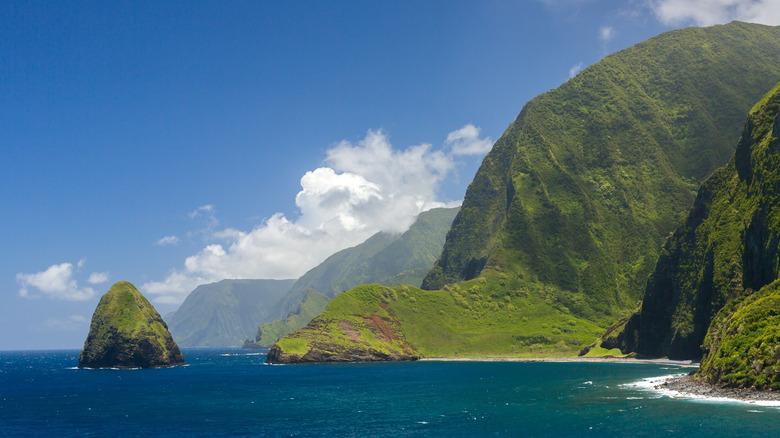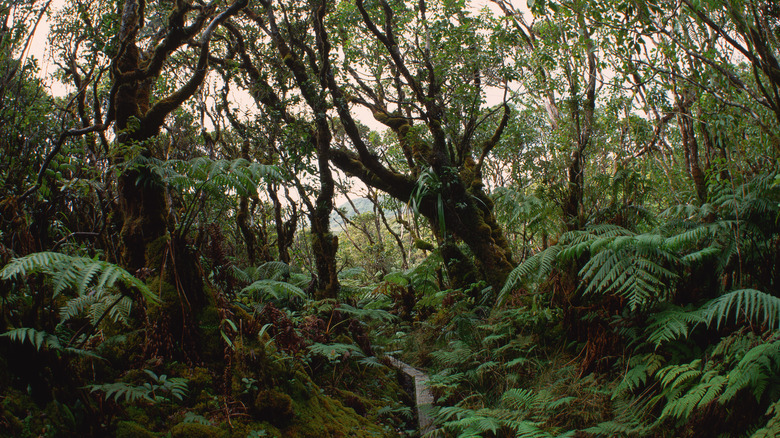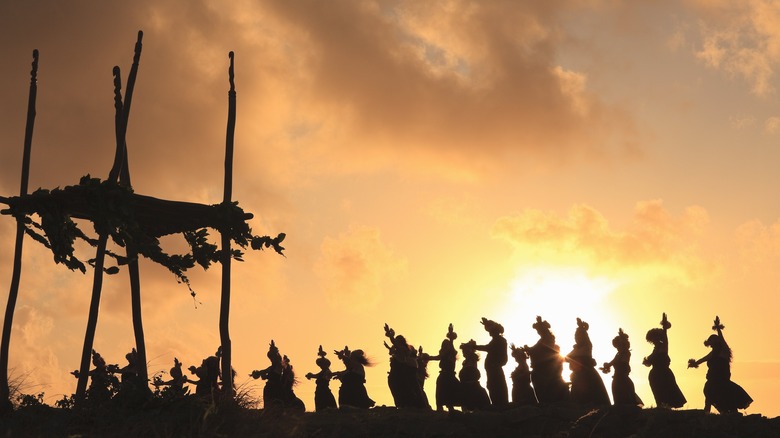This Hidden Gem Hawaiian Island Is A Quiet Escape With Pretty Beaches And Cliffside Views
Travelers will find no shortage of incredible adventures awaiting them in the Hawaiian islands, from swimming and snorkeling on the Big Island to visiting one of the world's best cliff-diving spots on Oahu. However, if you want to have a quiet and profound experience while learning about the history and culture of Hawaii, the island of Moloka'i might be for you. According to the Hawaii Department of Business, Economic Development & Tourism, in December 2022, nearly 487,000 people arrived in Oahu by plane, while in quiet Moloka'i, only 4,324 recorded visitors flew in. Even if you plan to visit at the peak of Hawaii's tourist season, you can book a flight from Honolulu to Moloka'i for around $100 – but most people don't.
Moloka'i may be small, only about nine-tenths the size of New York City, but coral reefs fill the surrounding ocean, 3,600-foot cliffs rise out of the water, and you can walk miles on a sandy beach without seeing another visitor. The only resort on the island has closed. Tourism as an industry remains highly controversial there, but Moloka'i is also known as "the friendly island" for a reason. It welcomes individual travelers, and locals will often engage visitors in conversation.
Why do so few people visit Moloka'i?
While it can be hard to understand why an island with white sand and tropical rainforests gets so few visitors, its landscape, history, and culture offer some clues. Like its towering sea cliffs, the island's traditional culture also resists interference from outsiders. According to Smithsonian Magazine, in the past, the people of Moloka'i had a reputation for using a combination of magic and poison to kill potential invaders of their land. In modern times, activists work to prevent their home from being transformed into a tourist trap. Travelers hoping to enjoy famous restaurants, luxury shopping, or the perks of booking an all-inclusive resort won't find these elements on Moloka'i, so many don't make the trip.
While some local businesses and volunteer programs rely on visitors to survive, many residents fear that outsiders will change Moloka'i. Some put up signs with messages like, "Visit. Spend. Go home." to remind visitors not to get too comfortable on Moloka'i, buy up the land, and price out local people, or, as one development company threatened to do, build a golf course over sacred land. Local cultural tour guide Greg Solatorio told Jim Byers Travel: "The island can't live without visitors ... It would be okay if the resort came back, but it would be nice if it was educational. We don't need more hotels handing out plumeria leis and teaching people to say, 'Hey, Brah.'"
How to experience Moloka'i for yourself
"If you come to Molokai to become part of what is here, you will be overwhelmed by the aloha and spirituality. If you bring your demands and lifestyle attitudes, you will be disappointed and will probably not find the island to your liking," states Visit Molokai, an organization created by people who live on the island to encourage the kind of tourism they want to see. If you plan ahead and travel thoughtfully, you can have an educational and perhaps even transformative trip. Best of all, you might even be able to leave the island better than you found it.
You could volunteer at the Kakahaia National Wildlife Refuge and help park staff remove invasive plants and replace them with native ones to help the endangered birds thrive there. You could get a permit, visit the Kalaupapa National Historical Park, and hike the trail to learn more about the island's history. As detailed in a report from Forbes, you might even be able to stay at a local farm for free in return for volunteering to assist the owners in their work. You could interact with the local people, asking their permission to explore their communities and enjoy the natural beauty of their island without disrupting it. In return, they may decide to share the most beautiful sights and experiences on Moloka'i.


